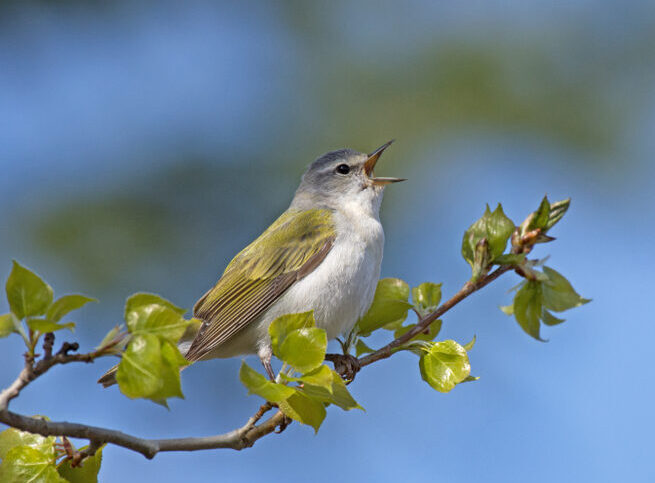Tennessee Warbler, Leiothlypis peregrina
Bill Rowe
The Tennessee Warbler is one of a large suite of warblers that winter in the tropics and then migrate north on a broad front, throughout the eastern United States, to reach their nesting grounds in the boreal forest of Canada, or at the northern fringes of the U.S., as in Minnesota and Maine. There they feast on the abundance of insects during the relatively short northern summer, especially the larvae of the spruce budworm moth. The fluctuations in this and other prey items are probably the main reason for ups and downs in the Tennessee’s population, but overall it remains one of the commonest warblers. Plainer than most of the others, the Tennessee more than makes up for that in spring with its persistent, unmistakable song that may seem to come from every treetop on some favorable days in May, letting you know that migration is really going strong. In the fall, it is less conspicuous because it’s not singing, but if you are attentive to the clusters of small birds moving through the foliage, you’ll discover again that the Tennessee is one of the most numerous migrants. At that season, you’ll also see it joining many other small birds lower down, in and out of shrubbery and dense weedy patches near the woods. Winter, spent from southern Mexico to Colombia and Venezuela, sees the Tennessee in many types of forest habitat, including second-growth woods and agricultural areas, especially coffee plantations. Note: Like many birds, it was named by the discoverer (in this case Alexander Wilson) for the place he first found it—but of course that was in migration. It could have been anywhere!
IDENTIFICATION: First, learn the song, a high-pitched series of chippery notes in three distinct sections, accelerating at the end. This will always identify a male Tennessee in spring. If you get a look, you’ll see the plain greenish back and wings, gray head with white eyebrow and dark eyeline, white underparts, and fine-pointed bill; the female is similar but less distinctly marked, with a tinge of yellowish or greenish below. Fall immatures are lightly to strongly yellow on the throat, fading to white under the tail; their wings sometimes show a slight wingbar. In all plumages, the bird is short-tailed for a warbler, a feature that helps separate it from its cousin the Orange-crowned Warbler, which tends to be drabber olive green or gray-green with blurry streaks below and yellow under the tail.
ST. LOUIS STATUS: Very common in spring, mostly May, and again in fall, mostly September and early October.
Learn more and listen to the songs and calls of Tennessee Warblers here.


Adult Female
Immature: Note green back, yellow throat, white undertail, short tail, and slight wingbar.
Photo Credit: Al Smith




